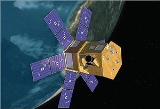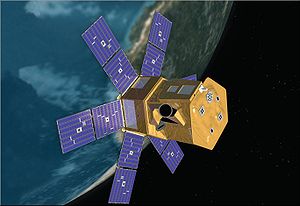
SORCE
Encyclopedia
 SORCE in flight |
|
| Organization | NASA NASA The National Aeronautics and Space Administration is the agency of the United States government that is responsible for the nation's civilian space program and for aeronautics and aerospace research... , LASP Laboratory for Atmospheric and Space Physics The Laboratory for Atmospheric and Space Physics is a research organization at the University of Colorado at Boulder. LASP is a research institute with over 100 research scientists ranging in fields from solar influences, to Earth's and other planetary atmospherics processes, space weather, space... at CU-Boulder University of Colorado at Boulder The University of Colorado Boulder is a public research university located in Boulder, Colorado... |
|---|---|
| Contractor | Orbital Sciences Corporation Orbital Sciences Corporation Orbital Sciences Corporation is an American company which specializes in the manufacturing and launch of satellites. Its Launch Systems Group is heavily involved with missile defense launch systems... |
| Mission Type | Astrophysics Astrophysics Astrophysics is the branch of astronomy that deals with the physics of the universe, including the physical properties of celestial objects, as well as their interactions and behavior... |
| Satellite of | Earth Earth Earth is the third planet from the Sun, and the densest and fifth-largest of the eight planets in the Solar System. It is also the largest of the Solar System's four terrestrial planets... |
| Launch | January 25, 2003 on a Pegasus XL |
| Launch site | Cape Canaveral Cape Canaveral Cape Canaveral, from the Spanish Cabo Cañaveral, is a headland in Brevard County, Florida, United States, near the center of the state's Atlantic coast. Known as Cape Kennedy from 1963 to 1973, it lies east of Merritt Island, separated from it by the Banana River.It is part of a region known as the... |
| Mission duration | 6 years |
| Mass Mass Mass can be defined as a quantitive measure of the resistance an object has to change in its velocity.In physics, mass commonly refers to any of the following three properties of matter, which have been shown experimentally to be equivalent:... |
315 kg (launch), 290 kg (dry) |
| Webpage | http://lasp.colorado.edu/sorce/ |
| Orbital elements | |
| Semi-major axis Semi-major axis The major axis of an ellipse is its longest diameter, a line that runs through the centre and both foci, its ends being at the widest points of the shape... |
7002.26 km |
| Eccentricity Orbital eccentricity The orbital eccentricity of an astronomical body is the amount by which its orbit deviates from a perfect circle, where 0 is perfectly circular, and 1.0 is a parabola, and no longer a closed orbit... |
.0024 |
| Inclination Inclination Inclination in general is the angle between a reference plane and another plane or axis of direction.-Orbits:The inclination is one of the six orbital parameters describing the shape and orientation of a celestial orbit... |
39.99 degrees |
| Orbital Period | 97.19 minutes |
| Right ascension Right ascension Right ascension is the astronomical term for one of the two coordinates of a point on the celestial sphere when using the equatorial coordinate system. The other coordinate is the declination.-Explanation:... of the ascending node |
135.41 degrees |
| Argument of perigee | 136.06 degrees |
| Instruments | |
| TIM | Total Irradiance Solar variation Solar variation is the change in the amount of radiation emitted by the Sun and in its spectral distribution over years to millennia. These variations have periodic components, the main one being the approximately 11-year solar cycle . The changes also have aperiodic fluctuations... Monitor |
| SOLSTICE | Solar Stellar Irradiance Comparison Experiment |
| SIM | Spectral Irradiance Monitor |
| XPS | XUV Extreme ultraviolet Extreme Ultraviolet radiation is high-energy ultraviolet radiation, generally defined to be electromagnetic radiation in the part of the electromagnetic spectrum spanning wavelengths from 120 nm down to 10 nm, and therefore having photons with energies from 10 eV up to 124 eV... Photometer System |
The Solar Radiation and Climate Experiment (SORCE) is a NASA
NASA
The National Aeronautics and Space Administration is the agency of the United States government that is responsible for the nation's civilian space program and for aeronautics and aerospace research...
-sponsored satellite mission that provides state-of-the-art measurements of incoming X-ray, ultraviolet
Ultraviolet
Ultraviolet light is electromagnetic radiation with a wavelength shorter than that of visible light, but longer than X-rays, in the range 10 nm to 400 nm, and energies from 3 eV to 124 eV...
, visible
Visible spectrum
The visible spectrum is the portion of the electromagnetic spectrum that is visible to the human eye. Electromagnetic radiation in this range of wavelengths is called visible light or simply light. A typical human eye will respond to wavelengths from about 390 to 750 nm. In terms of...
, near-infrared
Infrared
Infrared light is electromagnetic radiation with a wavelength longer than that of visible light, measured from the nominal edge of visible red light at 0.74 micrometres , and extending conventionally to 300 µm...
, and total solar radiation. The measurements provided by SORCE specifically address long-term climate change
Climate change
Climate change is a significant and lasting change in the statistical distribution of weather patterns over periods ranging from decades to millions of years. It may be a change in average weather conditions or the distribution of events around that average...
, natural variability and enhanced climate prediction, and atmospheric ozone and UV-B radiation. These measurements are critical to studies of the Sun
Sun
The Sun is the star at the center of the Solar System. It is almost perfectly spherical and consists of hot plasma interwoven with magnetic fields...
; its effect on our Earth
Earth
Earth is the third planet from the Sun, and the densest and fifth-largest of the eight planets in the Solar System. It is also the largest of the Solar System's four terrestrial planets...
system; and its influence on humankind.
SORCE measures the Sun
Sun
The Sun is the star at the center of the Solar System. It is almost perfectly spherical and consists of hot plasma interwoven with magnetic fields...
's output with the use of state-of-the-art radiometers, spectrometers, photodiodes, detectors, and bolometers engineered into instruments mounted on a satellite
Satellite
In the context of spaceflight, a satellite is an object which has been placed into orbit by human endeavour. Such objects are sometimes called artificial satellites to distinguish them from natural satellites such as the Moon....
observatory. The SORCE satellite orbits around the Earth accumulating solar data. Spectral measurements identify the irradiance of the Sun by characterizing the Sun's energy and emissions in the form of color that can then be translated into quantities and elements of matter. Data obtained by the SORCE experiment can be used to model the Sun's output and to explain and predict the effect of the Sun's radiation on the Earth's atmosphere and climate.
The SORCE spacecraft launched on January 25, 2003 on a Pegasus XL launch vehicle to provide NASA
NASA
The National Aeronautics and Space Administration is the agency of the United States government that is responsible for the nation's civilian space program and for aeronautics and aerospace research...
's Earth Science Enterprise (ESE) with precise measurements of solar radiation. It launched into a 645-km, 40-degree orbit and is operated by the Laboratory for Atmospheric and Space Physics
Laboratory for Atmospheric and Space Physics
The Laboratory for Atmospheric and Space Physics is a research organization at the University of Colorado at Boulder. LASP is a research institute with over 100 research scientists ranging in fields from solar influences, to Earth's and other planetary atmospherics processes, space weather, space...
(LASP) at the University of Colorado at Boulder
University of Colorado at Boulder
The University of Colorado Boulder is a public research university located in Boulder, Colorado...
, Colorado
Colorado
Colorado is a U.S. state that encompasses much of the Rocky Mountains as well as the northeastern portion of the Colorado Plateau and the western edge of the Great Plains...
, USA. It will continue the precise measurements of total solar irradiance that began with the ERB instrument in 1979 and has continued to the present with the ACRIM series of measurements. SORCE will also provide the measurements of the solar spectral irradiance from 1 nm to 2000 nm, accounting for 95% of the spectral contribution to the total solar irradiance. SORCE carries four instruments including the Total Irradiance Monitor (TIM), Solar Stellar Irradiance Comparison Experiment (SOLSTICE), Spectral Irradiance Monitor (SIM), and the XUV Photometer System (XPS).

